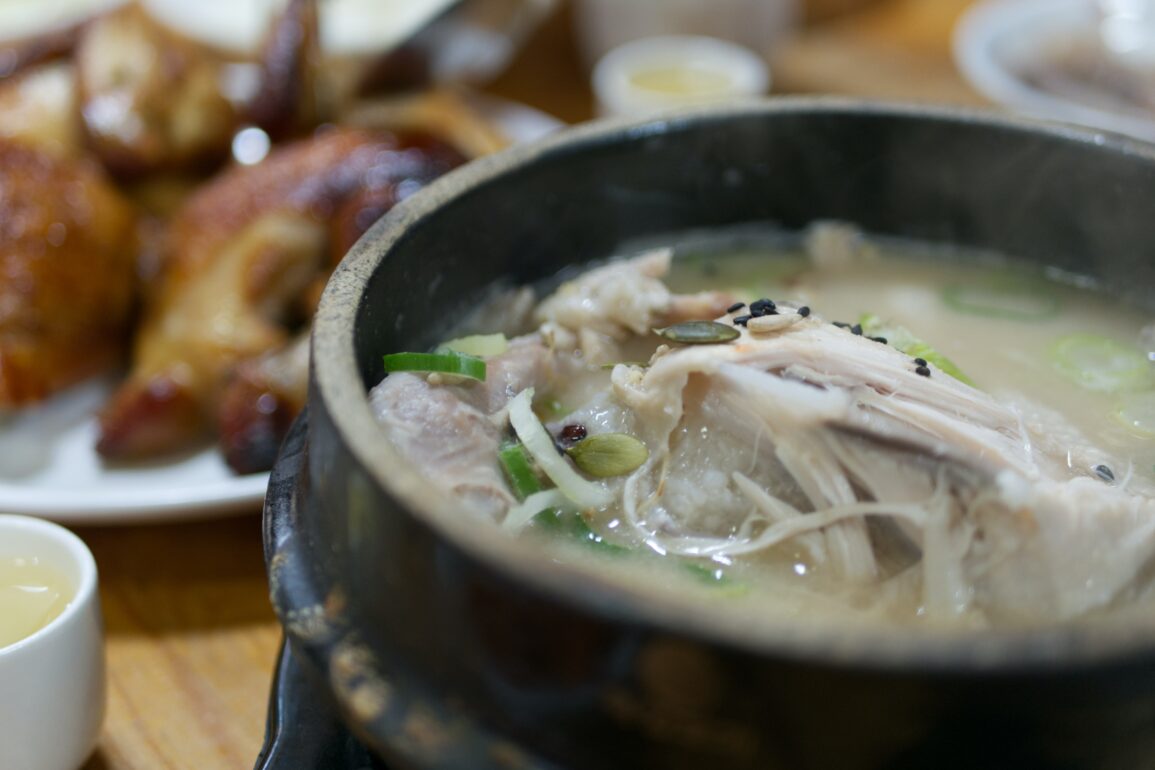After an uncharacteristically long spring, Korea’s stifling summer season is in full swing. And while many countries stow away their hearty winter recipes for the summer, opting for fresher and cooler cuisines, Koreans tackle the blistering, humid season in the same fashion as their ancestors: by indulging in a boiling, ginseng-infused chicken soup known as samgyetang (삼계탕).
Samgyetang is comprised of a whole, young chicken boiled alongside ginseng, jujubes, and garlic. While most soups are served with rice on the side, samgyetang serves the rice cooked inside the chicken. In turn, the rice soaks up the subtle yet delectable broth, making for a hearty bite.
While samgyetang is uniquely Korean, it mirrors dishes similar to its western counterparts. This may be due to the mild nature of the broth and absence of commonly used spicy pastes such as gochujang. When prepared correctly, the chicken melts off the bone into the soup. Samgyetang’s dense calories and fortifying broth is said to replenish the nutrients lost from the summer sweats. Don’t forget to order a side of ginseng infused soju to pair with your soup!
Heat Defeats Heat
There’s a Korean saying, “Iyeolchiyeol” (이열치열), which essentially means that “heat defeats heat,” so you’ll find Koreans queuing up at samgyetang restaurants on the three hottest days of the year, known as Sambok.
Sambok (삼복) refers the 40-day span of time in summer, usually between June, July, and August, where the three hottest days elapse. These days are categorized as Chobok (초복), Jungbok (중복), and Malbok (말복). They’re charted according to the lunar calendar and distinguish the beginning, middle, and end of summer. To better understand Sambok, it’s important to note that 초 means “beginning,” 중 means “middle” and of course, 말 stands for “end.”
According to the lunar calendar, Chobok occurs on the 28th day of the fifth lunar month, followed by Jungbok ten days later which lasts for 20 days. Finally, Malbok arrives, indicating ten more days of sweltering days before summer takes a back seat to autumn. As summers in Korea can be brutal and unforgiving, Malbok is often met with a bit of solace, knowing that the colorful leaves and crisp fall air is in the near future.
This year’s Sambok (the days when you should beat the
heat with a boiling bowl of samgyetang):
Chobok: July 16
Jungbok: July 26
Malbok: August 15

Photo: Paige Jones 
Photo: Paige Jones
Now that you understand sambok, you still may be wondering why Koreans choose to fuel themselves with boiling hot soup, instead of naengmyeon or bingsu. As mentioned, Koreans believe in fighting heat with heat. Therefore, by consuming a boiling, nutritious soup they are balancing their bodies and gathering stamina to conquer the dog days of summer. This belief isn’t uncommon and is seen in other Asian countries as well. This is why countries such as Vietnam, Indian, Thailand, for example, indulge in spice-packed curries and steaming bowls of noodles.
You can find samgyetang restaurants scattered throughout Seoul, and all across the country for that matter! During Sambok, families line up at famous samgyetang restaurants, sometimes waiting for over an hour in the heat to enjoy a bowl of chicken soup. Here are three samgyetang restaurants in Seoul worth a visit.
Ji-In Samgyetang (지인삼계탕)
Located at Isu Station, Ji-In Samgyetang (지인삼계탕), serves a delicious and fresh soup that won’t disappoint. The banchan dishes are extremely fresh and the ssamjang seemed to be prepared homemade. With a spotless interior and beautiful aesthetic, Ji-In makes for a perfect samgyetang experience. Beware though, the ginseng soju here is very strong! This restaurant gets very busy during Sambok, especially due to its limited seating, so it is recommended you make a reservation before you arrive.
Tosokchon Samgyetang (토속촌 삼계탕)
Next up is a famous samgyetang place known as Tosokchon Samgyetang. It’s located near Gyeongbokgung Palace and was often visited by late President Roh Moo-hyun. Alongside the classic ingredients of samgyetang, their soup also includes pumpkin seeds, sunflower seed, nuts, and pine nuts.
Goryeo Samgyetang (고려삼계탕)
Goryeo Samgyetang has been in business since the 1960s and was also been mentioned on the Michelin Guide. It serves a traditional style of samgyetang, as well as other variations. The best part? They serve a shot of ginseng on the side with each samgyetang dish.





